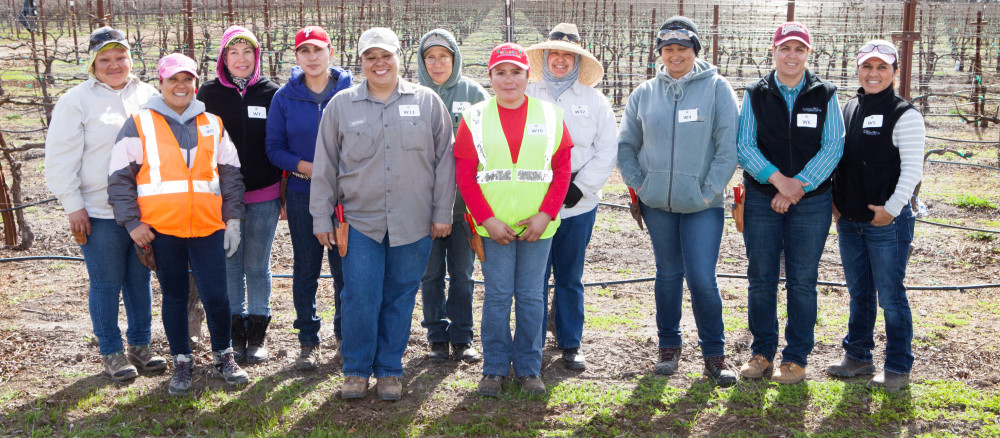By Joe Rodriguez
San Jose Mercury News.
Photo Credit: Robb McDonough.
YOUNTVILLE
Vineyard pruner Maria Romero and a dozen of her compañeras dressed a bit differently than the guys in this mecca of wine. The women wrapped stylish bandannas over their faces and wore wide-brimmed hats or hoodies to protect their skin against the sun and the stubborn branches they were about to trim from the grape vines.
“Before, it was only men who pruned the vines because it’s the hardest job,” the 28-year-old immigrant from Mexico said. “But now we’re proving we’re just as valiant.”
A poorly pruned vine produces too many grapes without vigor and too few with the flavorful balance the world’s finest winemakers demand.
And up until recently, pruning has been overwhelmingly a man’s job. But that changed this week, when women — for the first time — competed in the annual Napa County Pruning Contest on Feb. 20 at Beringer’s Gamble Ranch.
Romero lifted her pruning shears, showed off her white-and-blue nail polish, and pruned five, mature chardonnay vines at such a furious pace it sounded like a piano chord when she pulled the branches of the wire trellis. She cheered at her time — 2 minutes, 40 seconds — which would prove good enough for a second-place finish against the other women.
The women said their participation is not so much about breaking through a macho barrier as it is about immigration, agricultural economics and the Napa Valley’s ambition to be the best in and out of the corked bottle.
“Everything for us is better than before,” said Celia Perez, a 47-year-old mother of two. “We have reached the point where we enjoy higher pay and equality in field work.”
As if to prove it, she finished first in the women’s division with a time of 2 minutes, 4 seconds. In time, technique and quality Perez outperformed the men’s division winner.
“Wow, I wonder what the guys are saying now,” said Jennifer Kopp Putnam, executive director of the Napa Valley Growers Association. “Pruning has been such a male-dominated field for years and years.”
It wasn’t always that way. Maria Fuentes, at 60 the oldest among the men and women who competed, recalled that when she arrived from Mexico in 1977, “there were a lot of women pruning in the vineyards.”
“Then the men took over that job,” she said. “I don’t know why.”
Vineyard pruning has become a lot more demanding as Napa’s reputation as America’s premier wine-growing region has grown. Tourism has boomed. Restaurants and hotels have prospered. Highway 29, the main drag through the valley, is a crowded mess in the summer.
And some of that success has begun to benefit vineyard workers.
“We knew there were a lot of problems with poverty and housing in the wine industry and in agriculture in general,” Putnam said. “But we think of ourselves as more progressive, and I think we’ve done more than any other region to help farm workers.”
Specific numbers on wine vineyard wages and benefits are hard to come by, but the available numbers appear to back her up. A UC Davis report suggested Napa Valley farmworkers made about $9 an hour back in 2000. Though current comparable figures weren’t available, the Napa Valley Growers Association’s most recent survey of participating growers shows that the median wage for a vineyard laborer is $13.50 an hour. The median for a crew foreperson is $18 an hour. The median wage for vineyard supervisors is $29 an hour.
Putnam added that 69 percent of Napa vineyard workers are offered 401(k) retirement plans, 66 percent receive annual pay raises and 69 percent annual bonuses. The growers’ Farmworker Foundation offers classes in English, management skills, financial planning and personal health and safety.
Still, it took more than rising wages to propel more women into pruning and the celebrated competition. Putnam said growers saw a dramatic rise in applications from women with the start of the Great Recession in 2008. She estimates that women now make up 20 percent of the vineyard workforce.
Perez, the women’s winner in the pruning contest, now supervises her own crew. That was nearly unheard of a decade ago. In fact, she hadn’t pruned for a long time and had to practice the week before.
There was another competitor worth noting. Even though Laura Orozco didn’t win, her story brings social progress into the big picture.
The 38-year-old grew up in Napa Valley without pruning a single vine because her vineyard-working father wanted more for her. Orozco studied biology at UC Santa Cruz, returned to Napa for a laboratory job and is now a winemaker at V. Sattui Vineyards. She is one of relatively few Latina winemakers.
“I’m here because I wanted to be part of this history, to be with these women,” she said. “I also wanted to share some of my father’s experience. He always told me that the most important thing about making wine is what happens with the vines in the field.”
Napa wine in 2011
Licensed wineries: 789
Total cases of wine: 50 million
U.S retail sales: $10.1 billion
Exports: $84 million
Taxes paid: $1.3 billion
Charity contributions: $84 million
Full time jobs: 46,000
Vineyard wages: $120.5 million
Winery wages: $462 million
Source: Stonebridge Research Group, LLC: Economic Impact of Napa County’s Wine and Grapes, 2011.














































































































































































































































































































































































